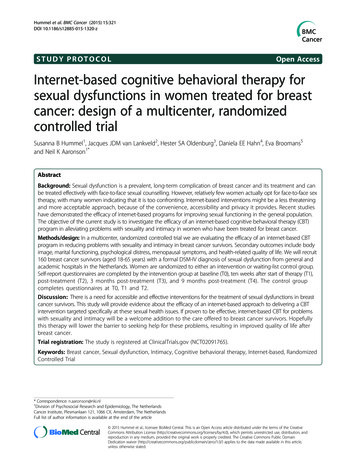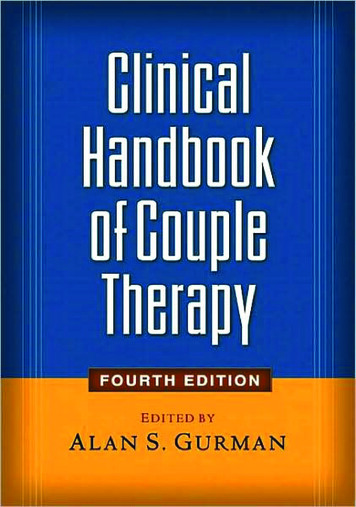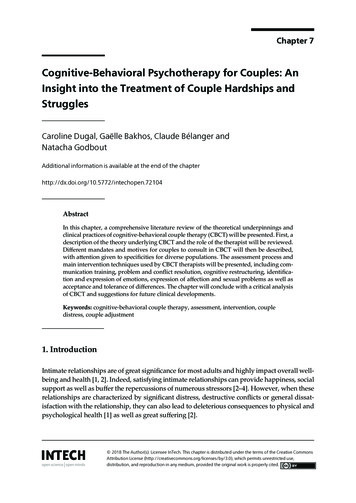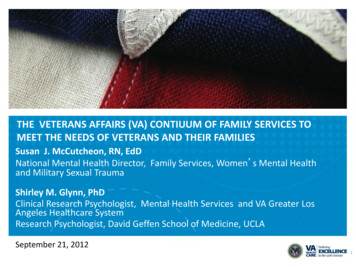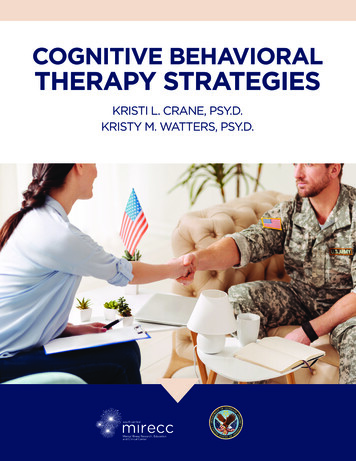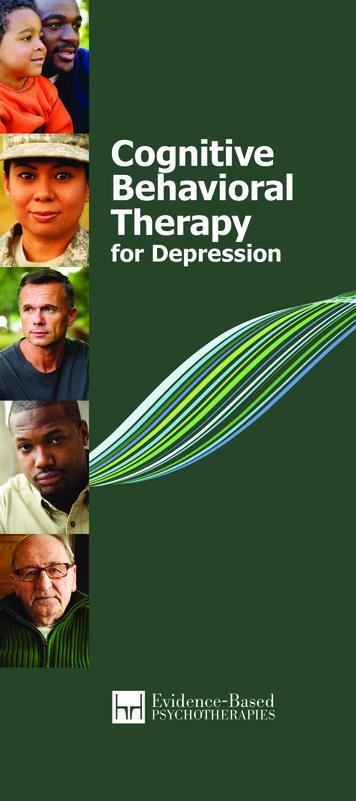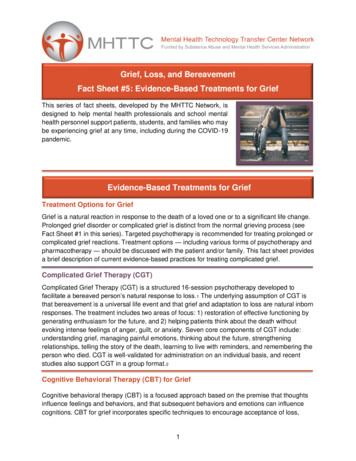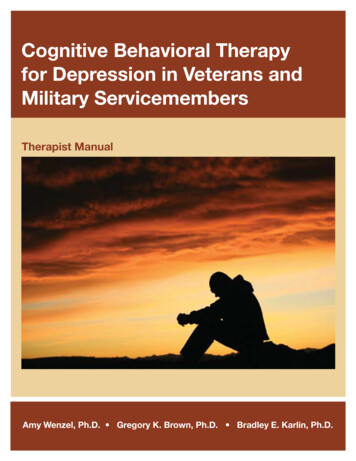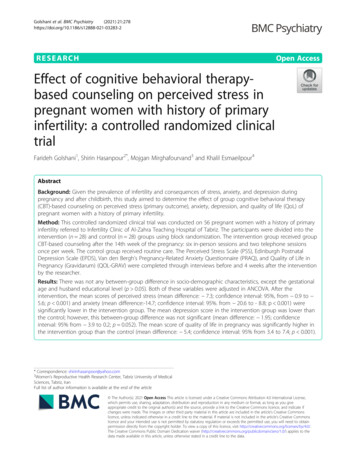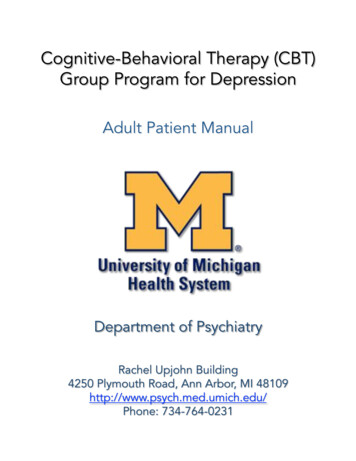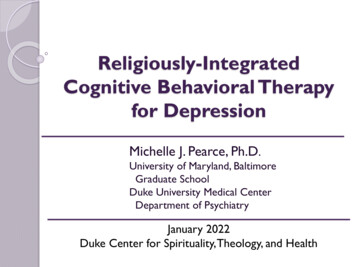
Transcription
Religiously-IntegratedCognitive Behavioral Therapyfor DepressionMichelle J. Pearce, Ph.D.University of Maryland, BaltimoreGraduate SchoolDuke University Medical CenterDepartment of PsychiatryJanuary 2022Duke Center for Spirituality, Theology, and Health
Objectives1.Why Religiously-Integrated CBT (RCBT)?2.How Can I Use It? 7 RCBT Tools3.Case Study Group Discussion4.Resources5.Q &A
AcknowledgementsPI: Harold G. Koenig, M.D.Department of PsychiatryDuke University Medical CenterPI: Michael King, MDDivision of Psychiatry, Faculty of Brain SciencesUniversity College, London, UKStudy Team in Durham, NC and Glendale, CAOur research was made possible by a grantfrom the John Templeton Foundation.
Why RCBT?
Does Religion Belong inPsychotherapy?If religion is important to a client,religion will be part of psychotherapywhether the therapist discusses it or not.How can we help our religious clientsengage with and use their faith as a healingresource in psychotherapy?(Pearce, 2016)
Does Talking About Religion HelpTreat Depression? Religious: Lessdepression; not exempt Faster resolution of symptoms 50-70% faster overall 100% faster w/ persistent physical disability ReligiousCBT as effective asconventional CBT for religious clients Improvement in psychological andspiritual health(e.g., Koenig et al., 2015; Koenig, King, & Carson, 2012; Oxhandler et al., 2019;Pearce, 2016; Rosmarin et al., 2019; Tulbure et al., 2018; Worthington et al., 2011)
Multi-site RCT of RCBTCompared remotely-delivered RCBT withconventional CBT for the treatment ofdepression among the medically ill N 132(RCBT 65; CBT 67) 69% female Mean age 51.6 years 52% Caucasian NC and CA(Koenig et al., 2015)
Multi-site RCT of RCBTManualized treatment with a patientworkbook 10 sessions (over 12 weeks); 50-60 minutes Delivered over *phone, Skype, IM Master’s level counselors 5 world religions: Christianity, Judaism, Islam,Hinduism, Buddhism
ResultsNo significant differences at baseline Religious affiliation in RCBT 87% Christian7.7% Buddhist1.5% Jewish1.5% Muslim1.5% HinduDepression (BDI-II) primary outcome Assessed at baseline, 4, 8, 12, and 24 weeks
Depression (BDI-II)30Baseline252012 weeksP 0.861510*524 weeksP 0.500CBTRCBT*Also improvement in positive outcomes, such asgratitude, altruism, and purpose in life(Koenig, Pearce et al., 2015)
What if Religion is Part of the Problem?Some religious beliefs may causedistress, but careful not to pathologizereligion as a whole Working with clergy Complementary roles Consultation and referral Cognitive RCBT tools Help to identify and challenge discrepanciesbetween beliefs/behaviors and client’sreligious value system
What is RCBT?
CBTMODELFeelingsThoughtsBehavior(Beck, 1979; 2005)
RCBTMODELFeelingsThoughtsBehaviorClient’s ReligiousTradition: Beliefs,Practices, Resources
How Can I Use It?7 Practical RCBT Tools
1. Renew Your Mind: Planting TruthFill your mind with positive and truthfulthoughts through mind-renewing activities,such as scripture memorization andcontemplative prayer Holy Texts used in RCBT manuals: Christian: Holy BibleJewish: Torah and TalmudHindu: Bhagavad GitaBuddhist: DhammapadaMuslim: Holy Qur’an
2. Change Your Mind: MetanoiaChallenging thoughts usingyour religious resources ABCD(R)E method(Thought Log) Theological reflections oncommon unhelpful thinkingstylesChallenge and replacenegative and unhelpfulthinking using client’s religiousbelief system
Theological Reflections on anUnhelpful Thinking StyleShould StatementsHolding and motivating yourself with fixed ideas abouthow the world “should,” “ought to,” or “must” be.E.g., A woman with depression who says to herself, "Ishould keep my house cleaner, and I shouldn't complain.”Theological Reflection from BuddhismWhen we use the word ‘should,’ there is generally littleroom for self-acceptance or flexibility. The Buddha taughtthat guidelines for our behavior can be important, but thatthese need to come from a place of higher wisdom andcaring for ourselves and others. Situations are oftencomplex, and a single mode of action or behavior is notdesirable or useful.
ABCD(R)E METHOD FOR CHALLENGINGTHOUGHTSActivating Event: Describe the situation when thenegative emotion(s) began.Every morning, I wake up with a feeling ofdread. I work from home and it is a battle toget out of bed and walk down the hall tostart work. There are things I could bedoing, but I can’t bring myself to start anyof them. I basically do nothing day afterday, week after week. It’s killing me.
ABCD(R)E METHOD FOR CHALLENGINGTHOUGHTSBeliefs: What negative beliefs or expectationsautomatically went through you mind when you were inthat situation?I’m incompetent and a fraud. There are so manythings I should know how to do, but don’t. My dadwould be ashamed of me if he were still alive.Consequent Feelings and Behavior: What feelings didthese beliefs lead to? Rate intensity of each (1-10). Whatbehavior did these beliefs and feelings lead to?-Sadness (8), self-pity (9), shame (9), anxiety (8)-After an hour or two of sitting in front of thecomputer doing nothing, I go watch TV.
ABCD(R)E METHOD FOR CHALLENGINGTHOUGHTSDispute the Beliefs: Specify the unhelpful thoughtcategory. What evidence is there that those beliefsmay not be accurate or true?Belief: “I’m incompetent and a fraud. There are so manythings I should know how to do, but don’t. My dad would beashamed of me if he were still alive.”-Labeling; Should Statement; Fortune telling-Evidence: I’ve never received poor feedback frommy boss. I am able to help my customers resolve manyof their problems.But I’m afraid that if I try to learn a new skill I’llfail, and failing would be worse than not trying at all.It would mean I really am incompetent.
ABCD(R)E METHOD FOR CHALLENGINGTHOUGHTSReligious Beliefs and Resources: How can your view ofGod/the Sacred, your religious worldview, sacred writings,spiritual wisdom, and other sources provide evidence thatchallenge your automatic negative beliefs?-”Therefore, there is now no condemnation for those who are inChrist Jesus.” (Romans 8:1) (shame-buster)-“Do not be anxious about anything, but in every situation, byprayer and petition, with thanksgiving, present your requests toGod.” (Philippians 4:6) (courage-booster)-”If any of you lacks wisdom, you should ask God, who givesgenerously to all without finding fault, and it will be given toyou.” (James 1:5) (shame-buster, promise of help)-If God isn’t condemning me, then I need to stop condemningmyself. I don’t have to do this on my own.
ABCD(R)E METHOD FOR CHALLENGINGTHOUGHTSEffective New Belief and Consequence:What is adifferent way to look at the situation? How did your feelingschange after you looked at the situation differently? Rateeach feeling using a scale of 1-10.-God said in every situation I can ask for his help,and that includes learning new skills for work. MyHeavenly Father already knows all my limitations andmistakes and he isn’t ashamed of me. Instead, hewants to give me strength and wisdom. If I make amistake, I won’t like it, but I can tell myself I’malready accepted, I’m human, and I can try again.-Hopeful (8), peaceful (9), confident (8)
3. Redemptive ReframingFinding God and the blessingin suffering Step 1: Sensitively explore (not solve!)spiritual suffering Why would a loving God let this happen? Is it a sin to be angry at God? Is God punishing me or abandoning me? Can process in journal or with therapistor clergy
3. Redemptive Reframing Step 2: Actively look for howGod may have been at work inyour life and what blessings might befound Meaning-making: How do your religious beliefshelp you make sense of this? Where might God’sloving hand be in this situation? Benefit-finding: Have there been any unexpectedblessings or silver linings? What have you learned?
4. Acceptance and ForgivenessLetting go and letting God Psychological and spiritual strategies forresponding to hurt and toxic emotions
4. Acceptance and ForgivenessSpiritual Surrender Active, spiritually motivated form of acceptance;intentionally letting go Accept/Surrender through prayer, letter to God,Gestalt empty chair, symbolic action
4. Acceptance and ForgivenessForgiveness:o 2 types: Decisional and Emotionalo Forgive after you process and validate the paino Targets of forgiveness: Self, others, God
5. Reach Out and ConnectInvolvement in religious community Combats social isolation and lack ofpurposeful activity Actively participate in religious community Live out faith by supporting others Identify someone in religiouscommunity with whom youcan spend time and forwhom you can pray
6. Say Thanks: GratitudePositive shift in focus and actions Notice the blessings one has been givenand express gratitude to God and others 2-Way Thanker
6. Say Thanks: Gratitude Count your blessings: Gratitude list Make a list of 10 things for which you aregrateful Renew your mind using gratitude Create new beliefs based on what has/is goingwell Gratitude letter Write a thank you letter to someone who hasmade a difference in your life Prayers of thanksgiving Pray though gratitude list or short prayers duringday to refocus attention
7. Giving Back: Service‘Tis better to givethan receive Shift the focus off ofoneself and one’sproblemsPlan act of service: Who,What, Where, When,How, and Why? Assess Impact: Mood,energy, relationships,esteem, spirituality
Summary of 7 RCBT Tools1.2.3.4.5.6.7.Renew your mind by planting God’s wordChange mind using a RCBT thought logDo a redemptive reframe (make meaningand find benefits)Accept/Surrender and forgiveReach out and connectPractice gratitudeServe others
Group Discussion:Case Study
Meet Hee JungHee Jung is a 31-year-old Asian ChristianProtestant woman who had a miscarriage twoyears ago. She was five months into herpregnancy at the time. She believes she is toblame. Although her faith is still important toher, she is deeply angry at God for not keepingher baby safe, as she believed he promised todo. She keeps her anger a secret because shethinks it is unchristian of her. She meetscriteria for depression.
Meet Hee JungHee Jung is a 31-year-old Asian Christian Protestant woman who had a miscarriagetwo years ago. She was five months into her pregnancy at the time. Being theconscientious woman she is, Hee Jung reported doing everything right in herpregnancy—taking prenatal vitamins, exercising, not drinking alcohol, gaining theproper amount of weight; however, she believes she is to blame for the miscarriagebecause she was stressed about work at the time it happened. Hee Jung refuses tobelieve her physician who said she was not to blame for the miscarriage.Hee Jung and her husband both grieved deeply for months after the loss. With time,her husband’s grief lessened, and recently he has brought up the idea of trying tohave another baby. In contrast, Hee Jung’s sadness has not abated, and she hasbecome increasingly irritable and withdrawn from her husband and her friends. Shelashes out each time her husband suggests they try getting pregnant. She doesn’t likethe woman she has become and is starting to lose hope that she’ll ever feel likeherself again.Hee Jung and her husband still go to church most weeks, but she no longer sits withor talks with her friends there. She is afraid to let anyone know how angry she is atGod because she doesn’t think it’s very “Christian” of her. In her first psychotherapysession, she told her psychologist the following:“You know what makes this even worse? I prayed over her in my womb everymorning and every evening for five months, asking God to keep her healthy and safe.The Bible says God will look after us and that he loves us, but he sure didn’tdemonstrate either of those things for me or my baby. I’m human and I doeverything in my power to keep my promises. God has unlimited power; he has noexcuse for not keeping his.”
Discussion Questions1.2.3.4.Is religion a source of comfort andstrength or a source of pain for HeeJung? How so?Would RCBT be a helpful approach?Why or why not?What RCBT tools would you use? Why?Would you consult with anyone? Who?
RCBT Resources
RCBT Training and Resources Free RCBT manuals and workbooks p/religiouscbt-study/therapy-manuals RCBT Training video eligious-cbtstudy/training-video/ For Christian clients: “Cognitive Behavioral Therapy for Christians withDepression: A Tool-Based Primer”(Pearce, 2016, Templeton Press) Online EdX Training Program in SpiritualCompetency: aining-inmental-health
Call for Proposals:Spiritual Competency Training inGraduate ciesproject.com/Click: “Funding Opportunity”
Thank you!michelle.pearce@umaryland.edu
Sample Study Publications Pearce, M.J., Koenig, H.G., Robins, C., Nelson, B., Shaw, S., Cohen,H., & King, M. (2014). Religiously-integrated cognitivebehavioral therapy: A new method of treatment for majordepression in patients with chronic medical illness.Psychotherapy: Theory, Research, and Practice. online publication.http://dx.doi.org/10.1037/a0036448 Koenig, H.G., Pearce, M.J., Nelson, B., Shaw, S.F., Robins, C.J., Daher,N., Cohen, H.J., Berk, L.S., Belinger, D., Pargament, K.I., Rosmarin,D.H., Vasegh, S., Kristeller, J., Juthani, N., Nies, D. & King, M.B. (2015).Religious vs. conventional cognitive-behavioral therapy formajor depression in persons with chronic medical illness:A pilot randomized trial. Journal of Nervous and Mental Disease,203(4), 243-251.
Letting go and letting God Psychological and spiritual strategies for responding to hurt and toxic emotions. 4. Acceptance and Forgiveness Spiritual Surrender . She keeps her anger a secret because she thinks it
